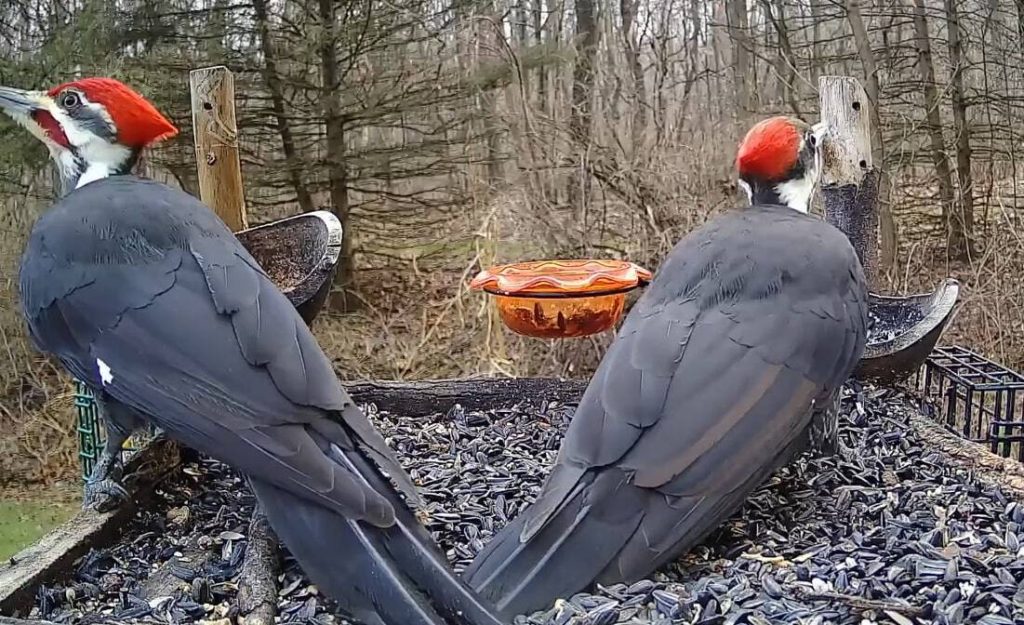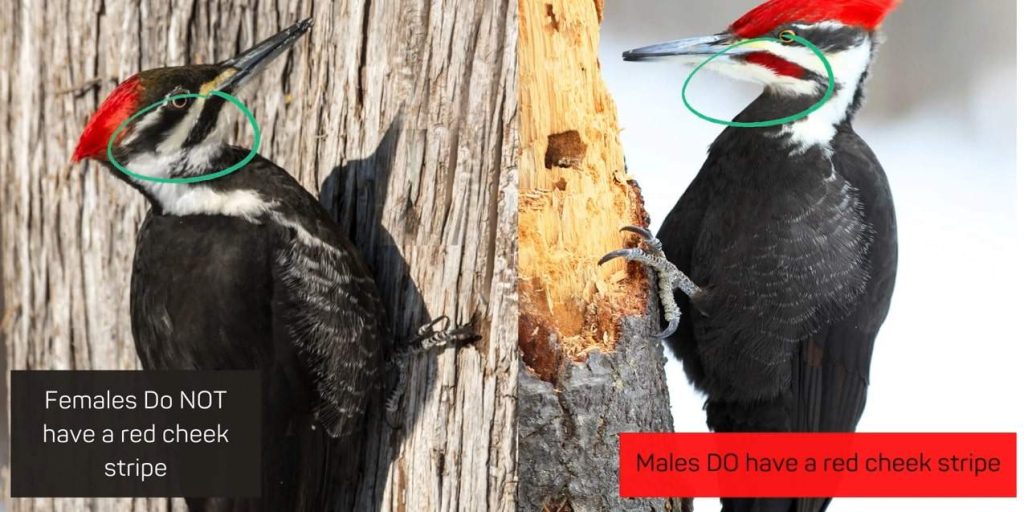For any bird enthusiast, spotting a pileated woodpecker is a thrill. Their majestic size and energetic drumming make them hard to miss. But it can be hard to tell apart the male and female pileated woodpecker.
As I’ve spent countless hours observing these incredible birds, I’ve learned to decipher the subtle differences between the sexes.
Male Vs Female Pileated Woodpecker
At first glance, differentiating between male and female pileated woodpeckers based on size and shape might seem like a challenge.
But, a closer look can make it easier for you to set them apart.
Body Size & Shape

Both sexes are impressive birds, boasting a length of 16-19 inches and a wingspan reaching around 29 inches. They share the same basic woodpecker build: a sturdy body, a strong chisel-like beak perfect for excavating wood, and stiff tail feathers for support while clinging to vertical surfaces.
However, a deeper dive reveals some subtle variations. Males tend to be slightly larger than females, with a weight difference of around two ounces – males averaging 13 ounces compared to the females’ 11 ounces. This size difference can be difficult to discern in the field though.
The key to telling them apart lies in the details of their head shape. Both males and females sport a bold red crest, a striking feature that makes them instantly recognizable. But upon closer inspection, you’ll see a distinction.
The male’s red crest extends further down the forehead, reaching almost to the base of his beak.
In contrast, the female’s red crest stops higher up, giving way to a patch of black feathers near the beak. This subtle difference is most evident when observing the bird from the side profile.
While these variations exist in pileated woodpecker size comparison, it’s important to remember that they’re relatively minor. Pileated woodpeckers are best distinguished through plumage coloration, which we’ll explore later.
Behavior
While size and shape offer some clues, I find that observing behavior can be a more reliable way to compare the male & female woodpeckers. This is especially true during the breeding season.
Both sexes are highly territorial, fiercely defending their established range against intruders. Their loud drumming on trees serves a dual purpose: attracting mates and asserting dominance over their territory.
However, during the nesting period, their roles begin to diverge slightly. The male typically initiates the excavation of the nesting cavity, using his powerful beak to chip away at dead trees.
This can be a noisy and time-consuming process, often lasting for several weeks. The female joins in later, assisting with the final touches and smoothing out the interior of the cavity.
Once the nest is complete, both parents share the responsibility of incubation and chick rearing. They take turns keeping the eggs warm and diligently hunt for insects, fruits, and nuts to feed their hungry offspring. This cooperative parenting style ensures the survival of their brood in a competitive environment.
Pileated woodpeckers are known to be intelligent birds, capable of using tools. They’ve been observed wedging nuts into bark crevices to hold them steady while they peck them open. This resourceful behavior demonstrates their ability to adapt and thrive in their forest habitat.
Color

While both male and female pileated woodpeckers are striking birds, their plumage offers the most definitive way to tell them apart.
Their overall body color scheme is quite similar – a combination of bold black, crisp white, and vibrant red. However, a closer look at woodpecker colors reveals a key difference in their facial markings.
The most prominent feature of both sexes is the unmistakable red crest gracing the top of their heads. This crest plays a vital role in attracting mates and establishing dominance. But upon closer inspection, a subtle detail emerges.
In males, the red coloration extends down the forehead, nearly reaching the base of their impressive beak. This creates a continuous red patch from the crown to the face.
In contrast, the red on a female pileated woodpecker stops short of the beak. The area near the base of the beak is instead colored black, forming a distinct black stripe on their face.
This subtle difference, often referred to as a “mustache” in males, is the most reliable way to distinguish the sexes, especially when observing the bird from the side.
Another, though less noticeable, color variation can be seen on the nape of the neck. Males tend to have a slightly more extensive red patch on the nape compared to females. However, this difference is even more subtle than the facial markings and requires a very clear view of the bird.
Wings
While plumage and behavior provide key clues for differentiating male and female pileated woodpeckers, their wings might seem less informative at first glance.
Both sexes share the same basic wing structure, essential for powerful flight and maneuverability through dense forests. Their wings are broad and rounded, allowing for bursts of speed and agile changes in direction as they navigate between trees.
The underside of the wings displays a bold pattern of black and white bars, creating a striking contrast that’s visible during flight.
But, look closer and you would see a subtle difference in wing coloration, albeit less pronounced than the variations seen in plumage.
The innermost flight feathers, closest to the body, are tipped with white in both males and females. But on males, these white tips tend to be slightly larger and more prominent compared to females.
This slight variation can be helpful for experienced birders when observing the bird in flight, particularly from below. It’s important to remember that wing coloration is not a foolproof method for identifying sex in pileated woodpeckers.
The difference in white tipping is minimal and requires a clear view of the bird in flight. Additionally, factors like lighting conditions and distance can further obscure this detail.
Therefore, focusing on plumage coloration, particularly the presence or absence of a red “mustache” on the face, remains the most reliable approach for differentiating male and female pileated woodpeckers.
Final Thoughts
While subtle, the differences between male and female pileated woodpeckers offer a glimpse into their fascinating world. By focusing on plumage and behavior, you’ll be well on your way to identifying these impressive birds on your next forest adventure.

